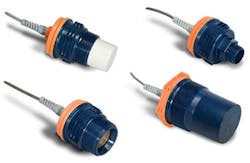What’s the difference between a $50 and $500 ultrasonic level sensor?
Ultrasonic level sensors come in a wide variety of sizes and prices. It all depends what your application will be and what your needs are.
Let’s compare the main uses of a $50 (or less) ultrasonic level sensor to a $500 advanced ultrasonic sensor.
$50 Ultrasonic Level Sensor
Most often basic ultrasonic sensors are used in pairs. One sensor is used to transmit the sound pulses and another sensor is used to receive the sound waves that have been bounced back from the target.
They are generally designed for short range general sensing applications such as position detection, position location and collision avoidance. Less expensive ultrasonic level sensors are manufactured mainly as a component piece suitable for mounting on a PCB board which is part of larger OEM devices such as robots, remote controlled vehicles and automobiles.
Because of their design and size, most basic ultrasonic sensors are made with factory preset parameters that are not adjustable. As a result, these sensors will be less accurate – the readings might differ based on fluctuations in temperature and humidity.
When choosing a basic ultrasonic sensor, you decide what sensing range you need and what transmitting frequency you need. Many basic ultrasonic level sensors transmit a pulse burst every 0.5ms at 40kHz.
Some basic ultrasonic sensors can be bought for less than $10. They are a simple choice for simple sensing. These are typically a cheap ultrasonic transducer on a basic circuit board without programming of any kind. These are great for hobbyists.
$500 Ultrasonic Level Sensor
Advanced ultrasonic level sensors are used when a constant, highly accurate measurement is desired. Examples are tanks, river heights and flood or flow levels as well object proximity as seen in a carwash. Full scale sensing ranges vary from as little as 79 inches up to 50 ft.
Advanced ultrasonic sensors are one piece sensors with outdoor rated housings. They have a single transducer that transmits and receives the ultrasonic sound wave.
Most models have an analog output such as current (4/20mA) or voltage (0-2 VDC or 0-5 VDC). Sold state relay outputs or NPN trip points are also common outputs.When installed, advanced ultrasonic sensors are mounted to their associated equipment usually with an NPT plug or bracket.
Here are a few examples of important parameters that are not adjustable with basic ultrasonic sensors but are user adjustable with advanced ultrasonic sensors.
- Blanking Distance – Sets the distance beginning at the sensor face to the point where the sensor will begin looking for target signals.
- Pulses – Controls the number of sound waves being sent in each ultrasonic burst.
- Sensitivity – Controls the level of amplification that is applied to a returning signal from the target.
- Temperature Compensation – A correction factor for changes in air temperature.
- Averaging – Defines the number of target samples (readings) that will be averaged together to become a distance reading.
- Analog Output – Sets the minimum and maximum sensing range for the application.
- Relay Set Points – Sets the minimum and maximum readings desired from the sensor for control purposes.
Though advanced ultrasonic level sensors are considerably more expensive (often greater than $500) than basic ultrasonic sensors, their durable construction, high accuracy, output capability, and adjustable parameters provide a great solution for countless non-contact measurement applications.
Gordon Greathouse is an Applications Engineer.
